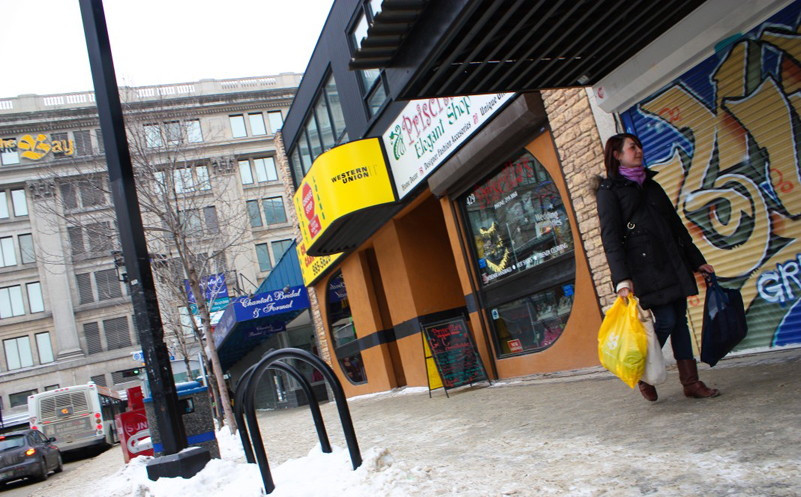Is it too late for Portage Avenue?
Not if the policies that have destroyed its character are drastically reversed
Recently, a New York marketing firm was hired to look into the prospects of downtown Winnipeg’s retail. Focusing on the three retail nodes – Graham, Portage and the Exchange District – the report assessed current realities and tabled recommendations for the future.
Lauded for its pragmatism, the report did not pretend that high-end boutiques like Holt Renfrew will triumphantly return to Portage anytime soon. Instead, it concluded that Winnipeg’s busiest street is best suited to discount retailers.
This might not have been what the groups that commissioned the study, including the Downtown BIZ and Centre Ventures Development Corporation, wanted to hear. But new studies mean new ways to spend public money.
In response to this study, these groups are looking at hiring a “retail specialist” (at $100,000 per year), and asking governments for up to a million dollars to help retailers.
But, if downtown retail is headed for the bargain basement, why pay someone six figures to oversee the descent? In any case, Portage Avenue has proven quite capable of attracting dollar stores and loan marts with the help of the countless millions already spent on renewal megaprojects, and on paying these very groups to advocate for revitalization and development.
Were it not for archival photos, books and grandparents, my generation might never know that Portage Avenue between Main Street and The Bay was once a grand and exciting place. Visual energy, texture and colour emanated from its architecture, storefronts and pedestrians.
Well into the 1950s, it was the city’s undisputed destination for movies, dining and shopping. At Christmas, even rural Manitobans would drive in to see the lights and window displays.
It is hard to know whether Portage was loved because it was New York and Chicago on a small scale, or because it was main street Manitoba on a grand scale.
What is clear is that today, it is neither. In 1955, the streetcars were removed. This was followed by parking restrictions, single-use zoning, the closing of the walkway at Portage and Main and the razing of most of the surrounding residential neighbourhood.
Increasingly, rapid car traffic replaced the wonder of a wide downtown street with the fear and placelessness of an eight-lane expressway.
Later, in a bid to stem the results of such destructive policies, Portage Place was built in 1986 as a three-block-long wall. Down the street, an intergalactic spacecraft known as the Air Canada Centre came to land where shops and apartments once stood at Portage and Carlton.
The hulking skywalks that crossed Portage killed whatever sense of place remained. Today, the Portage streetscape is a discordant and unattractive jumble of scales. Certainly not the place anyone could imagine grabbing a coffee and taking a stroll.
So far has Portage declined that there is a tendency to give up and let it go, to let the new generation of foolish renewal schemes bungle it further. The Exchange District and Graham Avenue are already islands of humanity downtown that have the ability to continue renewing themselves.
But Winnipeg cannot afford to let Portage go. It is still the psychological heart of the city, and for many Winnipeggers, downtown is Portage Avenue. It cannot be left as a source of civic embarrassment.
But to bring Portage back as a normal, enjoyable shopping street will take more than hiring experts to lure another Dollarama store, or adding another megaproject to the growing collection. It will take less of this, and more undoing of the damage wrought through the years. The barricades at Portage and Main, the skywalks across Portage, Air Canada Centre and all or part of Portage Place need to come down.
New construction must reflect traditional urban principles and uses. Also, some semblance of a streetcar system needs to be built.
To imagine Portage Avenue restored by anything less drastic is an admission that the status quo is quite fine, provided the money for more studies and self-serving renewal efforts keeps pouring in.
Robert Galston is a University of Winnipeg student who blogs about urban issues. Check him out at http://riseandsprawl.blogspot.com.
Published in Volume 64, Number 19 of The Uniter (February 11, 2010)







